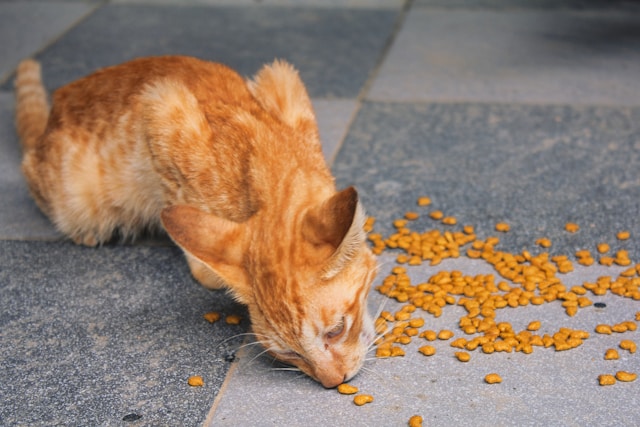Introduction
Raw food diets for pets have gained popularity as pet owners seek more natural and holistic options for their animals’ nutrition. Proponents argue that raw diets, often referred to as “BARF” (Biologically Appropriate Raw Food) or “prey model” diets, mimic what wild animals eat and can lead to improved health. However, there are concerns and risks associated with these diets as well. In this blog, we’ll explore the pros and cons of raw food diets for dogs and cats to help you make an informed decision for your furry friends.
The Pros of Raw Food Diets
- Improved Coat ConditionMany pet owners report that switching to a raw food diet results in shinier, healthier coats for their pets. Raw food provides essential fatty acids and nutrients that can enhance skin and fur health, leading to a more lustrous and less flaky coat.
- Better Dental HealthRaw diets, particularly those that include bones, can help clean dogs’ and cats’ teeth naturally. Chewing on raw bones can reduce tartar buildup and promote healthier gums, potentially decreasing the need for professional dental cleanings.
- Increased Energy LevelsSome pets on raw food diets exhibit higher energy levels and improved vitality. Raw foods are typically more nutrient-dense and can provide pets with the energy they need for an active lifestyle, potentially leading to better overall fitness and stamina.
- Improved DigestionRaw food diets are often easier for pets to digest because they contain natural enzymes and fewer processed ingredients. This can lead to firmer stools and reduced gastrointestinal issues, such as diarrhea and bloating.
- Allergy ReliefRaw diets eliminate many common allergens found in commercial pet foods, such as grains and artificial additives. Pets with food sensitivities or allergies may experience relief from symptoms like itching, ear infections, and digestive upset.
- Weight ManagementRaw food diets can help with weight management as they often contain fewer carbohydrates and fillers compared to commercial pet foods. The high protein content in raw diets can help pets maintain lean muscle mass and avoid obesity.
The Cons of Raw Food Diets
- Nutritional ImbalancesOne of the biggest challenges with raw food diets is ensuring that they are nutritionally balanced. Without careful planning and proper supplementation, pets may miss out on essential vitamins and minerals, leading to deficiencies or imbalances.
- Risk of Bacterial ContaminationRaw meats and bones can carry harmful bacteria, such as Salmonella or E. coli. Handling raw food requires strict hygiene practices to prevent contamination of surfaces and potential infection in both pets and humans.
- Bone HazardsWhile raw bones can be beneficial for dental health, they also pose risks. Cooked bones, in particular, can splinter and cause serious injuries to pets’ digestive tracts. Even raw bones can pose choking hazards or cause blockages if not appropriately sized.
- Cost and ConvenienceRaw food diets can be more expensive than commercial pet foods. The cost of high-quality meat, supplements, and careful food handling can add up. Additionally, preparing raw meals can be time-consuming and requires proper storage and handling.
- Lack of RegulationUnlike commercial pet foods, raw food diets are not subject to the same level of regulation. This lack of oversight can lead to inconsistencies in quality and nutritional content, potentially impacting your pet’s health.
- Potential for ObesitySome raw diets, particularly those that are not carefully balanced, can be high in fat. If not managed correctly, this can lead to weight gain or obesity, especially if the diet is not adjusted to the pet’s activity level and needs.
Tips for Transitioning to a Raw Food Diet
- Consult Your VeterinarianBefore making any changes to your pet’s diet, consult with your veterinarian. They can provide guidance on whether a raw food diet is appropriate for your pet and help you design a balanced meal plan.
- Start SlowlyTransitioning to a raw food diet should be done gradually. Begin by mixing a small amount of raw food with your pet’s current diet and slowly increase the proportion of raw food over time. This helps prevent digestive upset and allows your pet to adjust.
- Ensure Nutritional BalanceWork with a veterinary nutritionist to ensure that the raw food diet is nutritionally balanced. This may involve adding supplements or carefully selecting ingredients to meet your pet’s specific dietary needs.
- Practice Safe HandlingFollow strict hygiene practices when handling raw food. Use separate cutting boards and utensils, wash your hands thoroughly, and clean surfaces regularly to prevent bacterial contamination.
- Monitor Your Pet’s HealthKeep a close eye on your pet’s health and behavior after switching to a raw food diet. Regular check-ups with your veterinarian can help you identify any issues and make necessary adjustments to the diet.
- Consider Commercial Raw OptionsIf preparing raw food at home seems daunting, consider commercial raw food options that are pre-packaged and formulated to meet nutritional standards. These can provide convenience and ensure balanced nutrition.
Conclusion
Raw food diets for dogs and cats offer potential benefits, such as improved coat condition, better dental health, and increased energy levels. However, they also come with risks, including nutritional imbalances, bacterial contamination, and bone hazards. Careful planning, proper handling, and consultation with veterinary professionals are essential for ensuring a safe and balanced diet for your pets. By weighing the pros and cons and making informed decisions, you can provide your furry companions with the best possible nutrition and care.











Leave a Reply